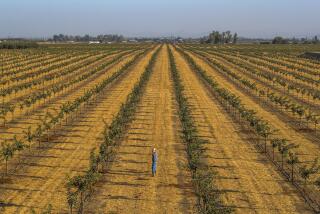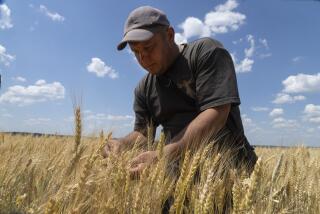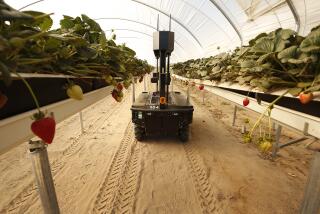Farm Export Boom Illusory, Analyst Warns : Sees Improvement Only if World Demand Picks Up
- Share via
FRESNO — A cheaper dollar and export subsidies at home and abroad are deluding farmers into belief that agriculture “has turned the corner,” according to a leading American farm analyst specializing in global trends.
A series of one-shot events mistaken for trends has buoyed U.S. agriculture recently, Dennis T. Avery, a former senior government analyst and now a private agricultural consultant, told a gathering a farm managers and rural appraisers recently in Fresno.
“Too many farming and farm-investment decisions have been made in the past on the basis of a weather event or a one-time government action,” Avery said. That pattern is repeating itself, he added.
Avery cited among factors distorting the present generally upbeat outlook for agriculture: a crop-killing monsoon in India, rain during a Soviet grain harvest, U.S. farm subsidies that rewarded growers for taking land out of production and a cheaper dollar that boosted U.S. exports at the expense of those of other countries.
“We are regaining some of the market share that we lost in the early 1980s due to high price supports and the strong U.S. dollar,” Avery explained. “Unless the world starts buying more total farm imports, however, the farm trade war must continue.”
That “war” results from national policies of self-sufficiency in agriculture, nurtured by protectionist trade practices that raise the cost of food at home while adding to a global grain glut, he said. “At least 30 countries” now dump surpluses on the depressed world market.
Fooled Earlier
“The biggest difference between 1978 and 1988,” Avery said, “is that world demand for farm imports has been rising only about half as rapidly in this decade as it did in the last one.”
Farmers in the 1970s were fooled by what he called a “false” increase in demand for food stimulated by the billions in petrodollars that flowed from developed countries to such populous oil-producing countries as Mexico, Nigeria and Indonesia. But, he added, when the price of oil fell, so did that demand for food.
“For agriculture to turn a real corner, the growth trend in world demand for farm imports must return,” said Avery, an associate with World Perspectives, a Washington agribusiness research and consulting firm. But during the next five years at least, he said, trends point toward continued overproduction induced by distortions created by government subsidies, which tend to offset one another while stifling demand for food by boosting domestic prices.
“World agriculture is a gigantic spider web,” he said, “and if you poke at it in one place it pulls on all the strands.”
California’s “strand” is increasingly important to the state’s economic well-being, according to the state Department of Food and Agriculture. California farmers depend on foreign sales (more than half to the Pacific Rim) for 20% of their income--about $3 billion of the $15 billion that the state’s farmers earned last year. The total effect in the state is even greater, however: More than 160,000 jobs and nearly $12 billion in trade-related economic activity.
U.S. agriculture’s “best shot” for the future lies in the current trade negotiations being conducted in Geneva under the 92-nation General Agreement on Tariffs and Trade. The United States has urged an end to agricultural tariffs and trade barriers by the year 2000--a proposal dismissed by the European Economic Community spokesmen as “unrealistic.”
“The Europeans want no part of it,” Avery acknowledged, adding: “And the Japanese don’t want to even think about it.”
More to Read
Inside the business of entertainment
The Wide Shot brings you news, analysis and insights on everything from streaming wars to production — and what it all means for the future.
You may occasionally receive promotional content from the Los Angeles Times.









